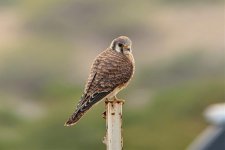I just spent time with two more specimens of the Nikon Monarch 82ED Fieldscope. I also got a look at the 30-60x zoom and the 30x eyepiece with reticle.
One of the scopes was excellent, nearly as good as the first scope I reviewed. The only problem I saw in a star test was a little spherical aberration, which reduced its resolution slightly to about 1.5 arc seconds, but I would still call it a cherry.
The second scope was not so good. Its star test showed some coma, more spherical aberration and an odd bright red ring outside of focus when it was defocused by about 4-5 rings. Its resolution was down to about 1.7 arc seconds, which was just noticeable as a softening of the image at higher magnifications compared to the other scope. I wouldn't call it a real lemon, just mediocre. Most people probably wouldn't notice anything wrong without a careful direct comparison, but this scope design can do better. Two cherry scopes out of three and no real lemons so far is a very promising result.
The 30-60 zoom does have a nice wide apparent field throughout the zoom range. I didn't have time to measure it, but comparing it to eyepieces I have measured I would estimate the true AFOV at 30x is about 58º and around 73º at 60x, as expected somewhat wider than the Nikon ISO specs. Distortion appears to be moderate pincushion, so no Globe Effect to deal with. With one exception off-axis performance is very good. There is a little field curvature and astigmatism at 30x, which gradually reduces to a very low level at 60x, The weakest off-axis characteristic is lateral chromatic aberration, particularly at high magnifications. At 60x there is an area near the center about 20º wide which is mostly free of lateral color, but for high contrast targets outside of that area the color fringes come on quickly and are pretty vivid at the field edge.
The 30x reticle eyepiece is an oddity for hunters and shooters only. Its optical performance is very similar if not identical to the 30-60 zoom set at 30x, with exactly the same field width and eye relief spec as the zoom.






